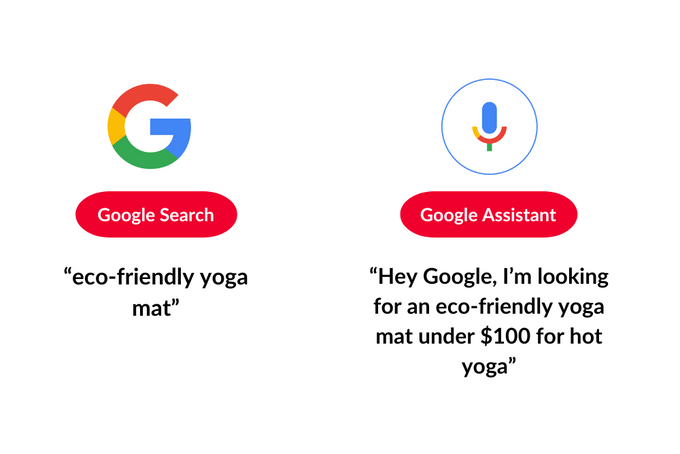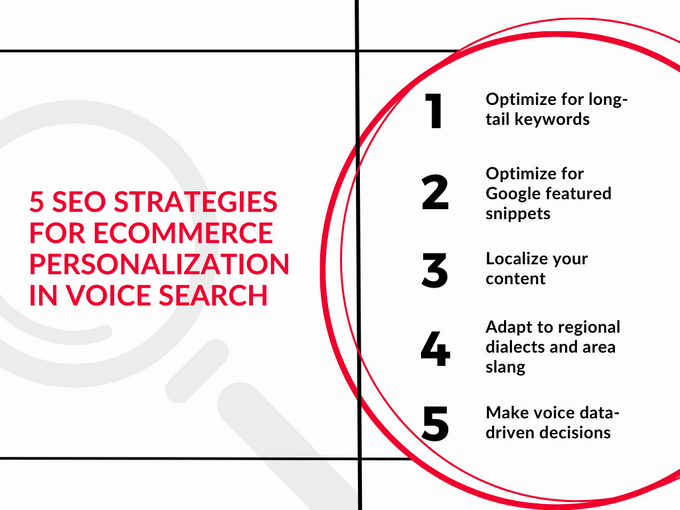How Voice Search Is Changing SEO: 5 Strategies for eCommerce Personalization
Speak the same language as your customers to optimize for voice search
Updated November 19, 2024

“Hey, Alexa, how is voice search changing SEO?”
Even if you haven't used voice search before, your customers probably have. Whether they’re looking up the number to a local restaurant while driving their kids to work or finding out how much a new Samsung device costs, voice search is becoming more common.
In fact, more than half of teens (and 41% of adults) use voice search daily. Those may be your present and future shoppers, so it’s not just important but vital to stay one step ahead and optimize your eCommerce store for voice search. Below, we break down how voice search is changing SEO plus the most essential strategies for eCommerce personalization, including:
- Optimizing for long-tail keywords
- Optimizing for Google featured snippets
- Localizing your content
- Adapting to regional dialects and area slang
- Making voice data-driven decisions
Meet the Expert
Jameela Ghann is a seasoned online store owner with over a decade of eCommerce experience. Apart from running Alora Boutique, she's also the marketing manager for Fera Product Reviews.
What Is Voice Search?
Voice search, also known as voice-enabled search, is when you use your voice to interact with a search engine as opposed to typing your query into a device.
It's important to distinguish that this speech-recognition technology isn't just a voice command like "Hey, Alexa, play Taylor Swift." Voice search is when you use your voice to navigate, search for products, and even make purchases (we call this voice commerce) by speaking to voice assistants like Amazon Alexa, Google Assistant, or Apple’s Siri.
How Is Voice Search Changing SEO?
Voice search is changing SEO by requiring businesses to focus on how people speak. This is called natural language processing. Voice searches resemble native speech patterns. Why? We talk to our devices like we talk to other humans. Because of this, keywords aren't the only component of voice search. You need to think about how people speak to capture more search traffic.
Consider the difference between a Google search vs a Google Assistant search for an eco-friendly yoga mat:
So, when you optimize for voice search in eCommerce, focus on both voice search intent and basic SEO tactics to cover all your bases. But how do you account for different speech patterns and vocabulary?
This is where eCommerce personalization comes in. Because voice search queries are typically more conversational and natural compared to text-based searches, personalization lets you understand the context and intent behind these queries better. This can then result in more relevant search results and product recommendations, potentially increasing conversions and sales.
Let's break down some of the key SEO strategies for eCommerce personalization in voice search.
1. Optimize for Long-Tail Keywords
Long-tail keywords are longer and more specific keyword phrases that users put into search engines when they're looking for very specific information.
This means you need to think about how someone would ask you the same question rather than simply how they would type it into Google. For example, instead of searching for “best smartphones,” someone might ask, “What are the best Android phones under $600?” or “What are the best Android phones for 5G?”
Optimizing for long-tail keywords can help you capture highly relevant traffic, even if it doesn’t capture a larger volume.
Consider including measurements, colors, and budget in your content. This can help you rank higher in search results and attract visitors who are more likely to convert.
2. Optimize for Google Featured Snippets
Google itself tells you that featured snippets—those little text boxes in the hallowed "position zero" of the search engine results page—are key for voice search. That's because Google Assistant and its voice search peers Siri, Alexa, and co often provide answers from this section.
To increase your chances of reaching position zero, aim to answer each question concisely and organize your content well. Google loves numbers, steps, and lists, so include them in your content.
3. Localize Your Content
Voice searches often revolve around local queries, and voice assistants are becoming adept at handling location-specific questions.
- Create content for your local audience.
- Use local keywords in your content, like in titles, meta descriptions, and headers.
- Keep your Google My Business listing complete and accurate.
Voice search is about convenience, used on the go for finding nearby stores or quick answers. Local keywords and information help users get what they need easily.
4. Adapt to Regional Dialects and Area Slang
Remember to take local slang and regional dialects into account. Your content and keywords should align with the natural speech patterns of your target audience.
For instance, the use of certain words or phrases could suggest that the speaker is from a younger generation or perhaps more urban. These are aspects that can be used for personalization.
While we may not be there yet, as we continue to optimize for natural language, we’ll gain a clearer understanding of who these individuals are, where they’re located, and what they desire.
5. Make Voice Data-Driven Decisions
Voice search data can give you insights to help you tailor your product and content decisions because you'll understand your users' preferences. For example, voice search data can help you enhance your recommendation algorithms.
Then you can make personalized product suggestions based on factors like region or voice characteristics to significantly improve the user experience.
The same goes for content. Many search apps include blog posts or how-tos in their search results. If users are frequently searching for video setup lighting, for example, you could create a blog post detailing the best lighting options. Aligning your content with common voice search queries is crucial for personalization.
Voice Search Optimization: A User-Centric Approach
The key to successful voice search optimization is focusing on the user. Don’t adopt a trend just because it’s new or exciting. Ensure it’s something your users will appreciate and find useful.
- Design an intuitive and convenient voice experience: Many users utilize voice search while multitasking. Make sure your voice interface is easy to use and adds value to their experience.
- Develop a user-centric app: If you decide to create an app, ensure it’s optimized for your eCommerce site. This includes providing high-quality content, structured data, mobile-friendliness, and incorporating local SEO if necessary.
- Prioritize data privacy: Compliance with data privacy is crucial. Avoid becoming the next company facing backlash due to privacy concerns.
- Be open to adaptation and innovation: Voice technology is still new, so be ready to change and innovate as needed. Don’t get too attached to one approach to voice search.
Remember, the ultimate goal is always to enhance the user experience. As technology evolves, so should your strategies. Be flexible, innovative, and always keep your users’ needs at the forefront.
Embracing the Future of Voice Search
Voice search is transforming SEO and eCommerce, driven by its increasing popularity among users of all ages. To thrive in this evolving landscape, businesses must adapt their SEO strategies to accommodate natural language processing and conversational content.
eCommerce personalization plays a pivotal role in voice search success, allowing for more contextually relevant results and recommendations.
Prioritizing the user experience is paramount, with a focus on intuitive voice interfaces, user-centric apps, data privacy, and adaptability as voice technology evolves. Embracing these changes positions businesses to excel in the era of voice search and enhance overall customer engagement.






